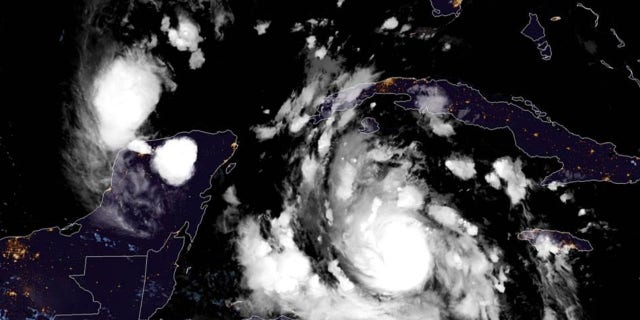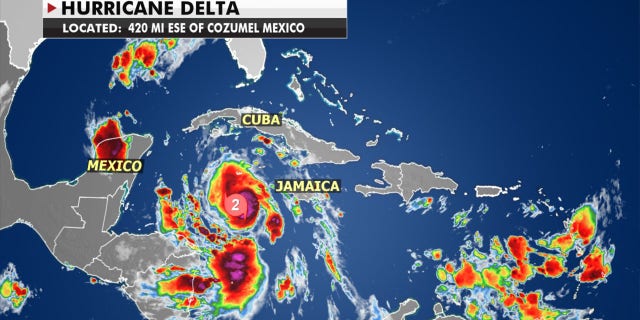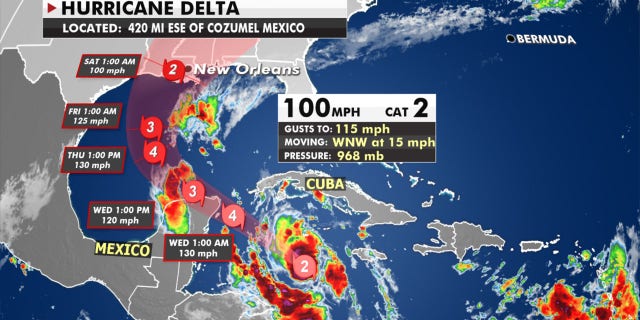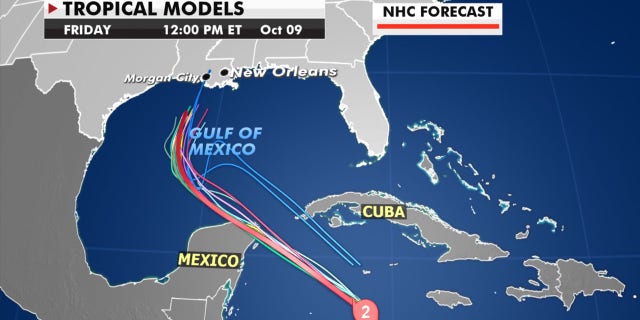A rapidly strengthening Hurricane Delta is taking aim at the resort hotspot of Mexico’s northeastern Yucatan Peninsula before targeting the U.S. Gulf Coast later this week.
The U.S. National Hurricane Center in Miami said Tuesday morning that Hurricane Delta is now a Category 2 storm, packing maximum sustained winds of 110 mph as it is located 370 miles east-southeast of Cozumel moving west-northwest at 15 mph.
“Delta rapidly intensifies into a Category 2 hurricane,” the NHC said Wednesday morning. “Extremely dangerous hurricane conditions expected for the northeastern Yucatan Peninsula starting early Wednesday.”
LIVE UPDATES: HURRICANE DELTA RAPIDLY INTENSIFIES, ‘EXTREMELY DANGEROUS’ CONDITIONS EXPECTED
The storm rapidly intensified overnight from having 80 mph winds into a Category 2 hurricane with 110 mph gales and is expected to strengthen even further as it moves north into the Gulf of Mexico.

Hurricane Delta, strengthening as it takes aim at Mexico’s Yucatan Peninsula, can be seen on satellite Oct. 6, 2020. (NOAA/GOES-East)
Delta is expected to become a major hurricane — Category 3 or higher — by the time it reaches the Yucatan Peninsula on Wednesday and remain a powerful storm over the Gulf of Mexico through at least Thursday.

Hurricane Delta is strengthening over the Caribbean Sea on Tuesday, Oct. 6, 2020. (Fox News)
Data from a U.S. Air Force Reserve Hurricane Hunter aircraft indicate that Delta will continue to strengthen as its forward speed increases, the NHC said.
HOW STRONG CAN HURRICANES GET? HERE’S A BREAKDOWN OF CATEGORIES AND THE SAFFIR-SIMPSON WIND SCALE
Forecasters from the NHC noted that Delta is expected to reach a Category 4 storm while in the Gulf of Mexico.
The brunt of the storm is expected to arrive along the northern Yucatan Peninsula starting Tuesday night, with a hurricane warning in effect for Tulum and Cozumel, resorts still being soaked by the remnants of Tropical Storm Gamma.

The forecast track of Hurricane Delta (Fox News)
The NHC is warning of an extremely dangerous storm surge raising water levels by as much as 6 to 9 feet, accompanied by large and dangerous waves and flash flooding inland.
TROPICAL STORM DELTA STRENGTHENS IN CARIBBEAN, FORECAST TO TARGET GULF COAST AS HURRICANE
Delta “presents an important danger for the coastal regions” because of the storm surge in the lower parts of Quintana Roo, such as the resorts of Cancun, Holbox island or Isla Mujeres, Jorge Zavala, head of Mexico’s meteorological service, said in a press conference late Monday. The area is still feeling impacts from Tropical Storm Gamma.

Mexico’s Yucatan Peninsula is still feeling the impacts from Tropical Storm Gamma. (Fox News)
Zavala said preventative evacuations would begin Tuesday morning.
Once Delta moves through Mexico, the storm is expected to curve in the Gulf of Mexico and take aim around Friday on the U.S. Gulf Coast.
Energy companies were also taking precautions on oil rigs, pulling nonessential workers from platforms on Monday in preparation for the storm’s arrival.
Right now, it appears Louisiana will take the brunt of the worst of the impacts from this storm, but everyone along the coast needs to pay attention to the path of Delta.

Forecast models showing the track of Hurricane Delta (Fox News)
As the storm gets closer to the U.S., the potential for heavy rain and flash flooding will extend from the Gulf Coast to the Tennessee River Valley and across the Southeast.

Heavy rain and a flash flooding threat are possible into the weekend as Hurricane Delta approaches the Gulf Coast of the U.S. (Fox News)
Dangerous rip currents are also impacting Gulf Coast beaches, according to the National Weather Service (NWS) forecast office in Mobile, Ala.
If the storm makes landfall in the U.S., it would be the 10th storm to do so this season, which could break the record for storms to directly strike the continental U.S.
CLICK HERE FOR MORE WEATHER COVERAGE FROM FOX NEWS
Delta is the 25th named storm in the 2020 Atlantic hurricane season, setting yet another record. The previous record for the earliest 25th Atlantic named storm is Nov. 15, 2005, according to Colorado State University hurricane research scientist Phil Klotzbach.
NOAA forecasters have called for up to 25 named storms this season with winds of 39 mph or higher; of those, seven to 10 could become hurricanes. Among those hurricanes, three to six will be major, classified as Category 3, 4 and 5 with winds of 111 mph or higher.
That’s far above an average year. Based on 1981-to-2010 data, that is 12 named storms, six hurricanes and three major hurricanes.
CLICK HERE FOR THE FOX NEWS APP
So far this year, there have been 25 named storms, including eight hurricanes and of those, two major hurricanes. Delta would be the third major storm.
Laura caused major damage across southwestern Louisiana and southeastern Texas after roaring ashore as a Category 4 storm. Hurricane Sally made landfall last month in coastal Alabama, bringing damaging impacts along the Gulf Coast into Florida’s Panhandle region.
The last time the Greek alphabet was used in the Atlantic was in 2005, the year of Hurricane Katrina. With a total of 27 storms that year, the first six letters of the Greek alphabet were used: Alpha, Beta, Gamma, Delta, Epsilon and Zeta.
With weeks to go until the season officially ends, the 2020 season could set the record for most named storms.
Fox News’ Brandon Noriega and the Associated Press contributed to this report.
>>>details

